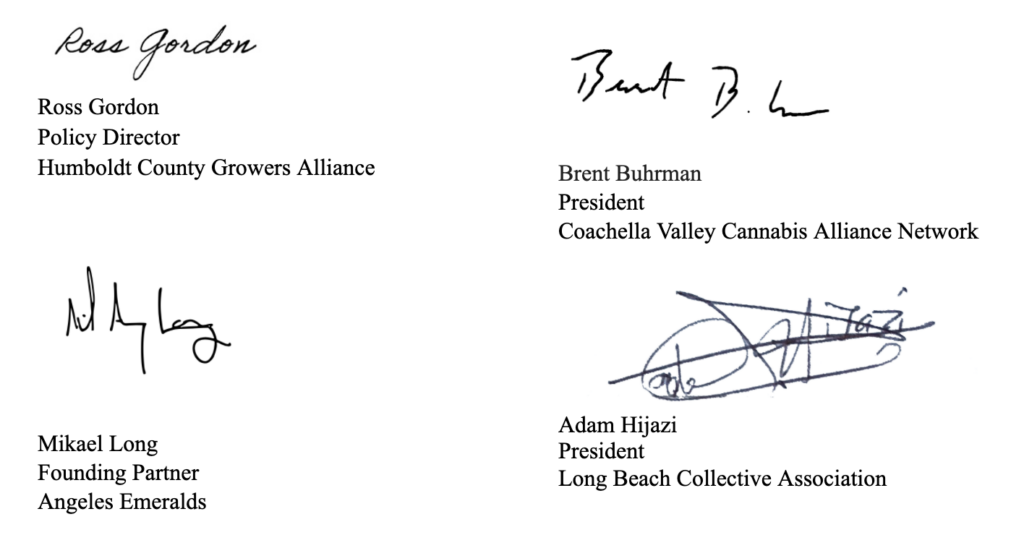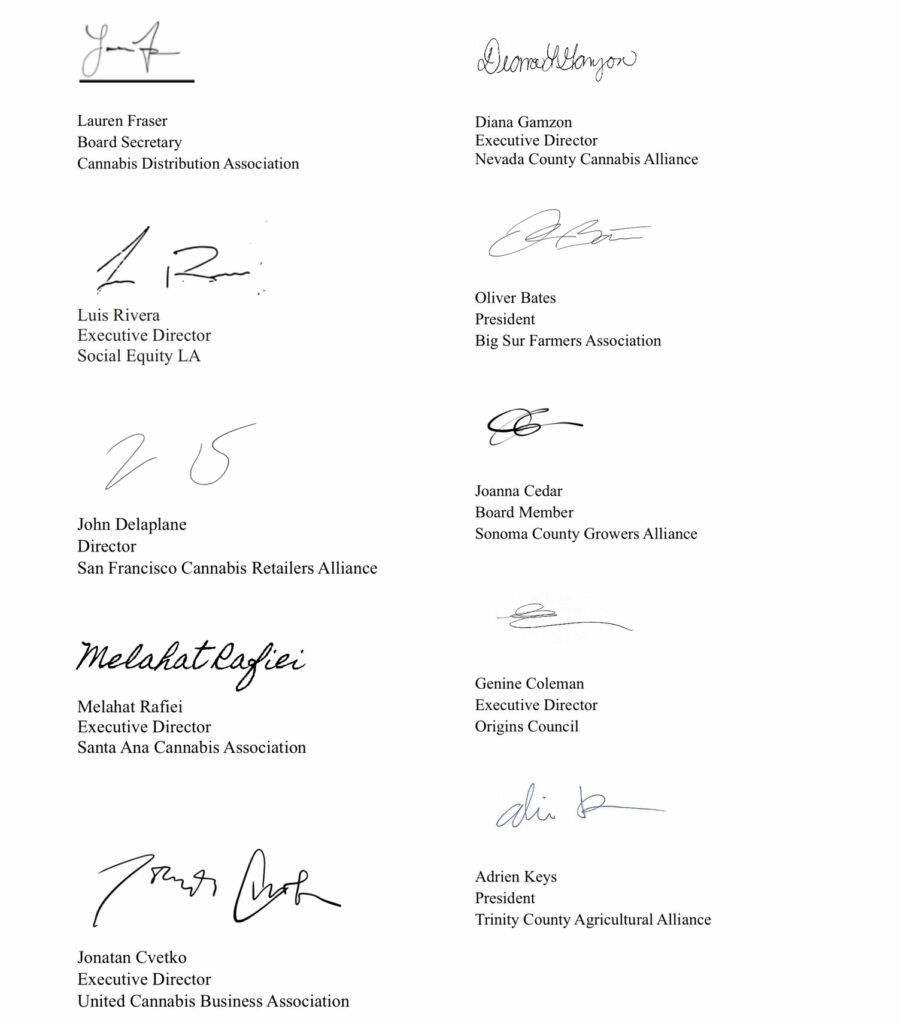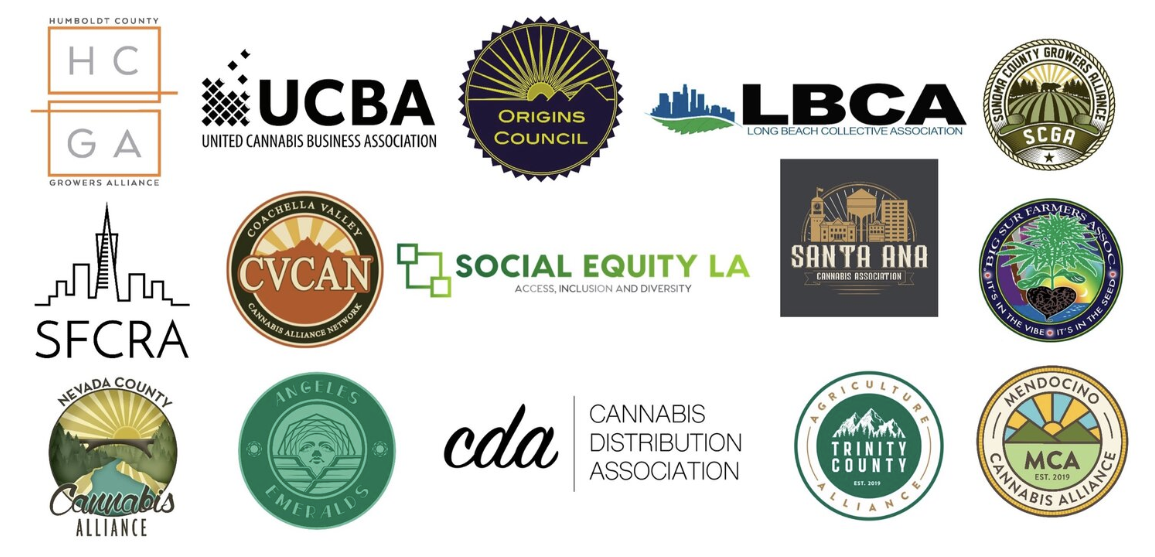Dear Senator Allen & Assemblywoman Aguiar-Curry:
On behalf of the undersigned organizations, representing over 1,300 cannabis licensees from all parts of the cannabis supply chain, we are writing to express our opposition to AB 45 (Aguiar-Curry) and SB 235 (Allen), unless amended.
Our organizations share a common perspective on many of the most crucial aspects of this proposed legislation. Specifically, we believe it is critical that any prospective hemp legislation protects the integrity of both hemp and cannabis products, and where they intersect. California hemp policy must protect consumer health and safety, and accurately delineate the ways in which hemp is both similar to and distinct from THC cannabis.
As written, AB 45 and SB 235 pose substantial risks to both public health and the integrity of the legal cannabis framework. We believe the following amendments are essential to addressing major gaps within the current hemp framework.
Issue #1: Psychoactive analogs of delta-9 THC, such as delta-8 THC and others, should be prohibited from being present in final form industrial hemp products beyond trace amounts. Loopholes that allow intoxicating compounds should be closed, with additional authority given to regulators to close future loopholes.
In late February, the New York Times published a detailed article on the rise of delta-8 THC “hemp.” The article describes how delta-8 THC, derived via chemical synthesis from hemp CBD, produces psychoactive effects near-identical to delta-9 THC, and is sold across the country under a claimed federal legal loophole.
This legal loophole is reaffirmed within AB 45 as written. By defining “THC” specifically as “delta-9 tetrahydrocannabinol, Chemical Abstracts Service (CAS) number 1972-08-3,” AB 45 specifically excludes delta-8 THC and all other psychoactive analogs, thus allowing them in hemp and final form hemp products.
We appreciate recent amendments to SB 235, which add delta-8 THC and delta-10 THC to the definition of “THC,” thereby prohibiting these analogues in hemp products. However, this protection has yet to be amended into AB 45. Additionally, SB 235 should be amended further to anticipate the rise of other synthetic THC analogues in response to a prohibition on delta-8 and delta-10 THC. Additional psychoactive analogs of delta-9 THC include exo-THC, delta-9 THCP, HHC, and THCV. Each of these are allowed under the current legal loophole. We anticipate that other psychoactive analogs are likely to become prevalent in the future, absent some statutory or regulatory mechanism that definitively excludes them.
Recommendation #1: Explicitly prohibit delta-9 THC and its psychoactive analogs in final form hemp products beyond trace amounts. Additional authority should be given to regulators to determine and restrict other intoxicating cannabinoids with properties similar to delta-9 THC.
Issue #2: THC limits in final form manufactured hemp products should be quantified in terms of milligrams, rather than by a percentage of the final form product’s weight. We recommend that permissible amounts not exceed 0.1mg THC per final form manufactured hemp product.
As drafted, Section 111925 (a)(3) has the unintended consequence of allowing higher amounts
of THC in hemp products than in the cannabis industry’s BCC and DPH regulations, which require all edible cannabis products to contain no more than 100mg THC per package. The unintended potency problems stem from confusion caused by the 0.3% designation, which was only intended to define the permissible potency of commodity hemp during farming, not describe permissible potencies of final form products which will differ in weight according to their size and form factor.
AB 45 and SB 235 should call out maximum THC thresholds for final form manufactured hemp products in terms of milligrams, rather than by a percentage of the particular product’s weight. The problematic sentence in existing language has been bolded and underlined below:
(3) The manufacturer of the hemp extract in its final form or the final form industrial hemp product shall be able to prove total THC concentration does not exceed 0.3 percent. A manufacturer of raw extract shall be able to prove that the THC concentration meets department requirements set forth pursuant to subdivision (a) of Section 111921.
Using this problematic, “does not exceed 0.3 percent” concentration by weight rationale, see what happens in the product examples below, which all weigh different amounts:
- A single 3 gram multivitamin or gelcap containing 0.3% THC by weight contains 9mg THC.
- A single 5 gram gummy containing 0.3% THC by weight contains 15mg THC.
- A standard 44 gram Hershey’s chocolate bar containing 0.3% THC by weight contains 132mg THC.
- A standard 3.5oz/100 gram brownie containing 0.3% THC by weight contains 300mg THC.
- A 16oz (473 gram) iced tea containing 0.3% THC by weight contains 1,419 mg THC.
Recommendation #2: Include a milligram-based limit of up to 0.1mg Delta-9 THC and its psychoactive analogs per package final form manufactured hemp product, which would assure that a person purchasing one or multiple final form hemp products would not consume a psychoactive dose of THC. This prohibition should also apply to psychoactive cannabinoids derived from sources other than hemp, such as cannabinoids synthesized from non-cannabis and non-hemp botanical products.
Additionally, legislation should clarify that the practice of marketing the permissible THC content in hemp products should be banned to avoid opportunistic and misleading product claims.
Issue #3: Cannabis and hemp products should be tested at parity for pesticides, heavy metals, and other contaminants.
Adulterants in cannabis products and hemp-derived products pose identical risks to consumer health, and should be tested to the same standards. Hemp-derived products are often only distinguishable from cannabis products by their relative absence of THC. This relative absence of THC does not indicate if a hemp product’s levels of pesticides, solvents, or heavy metals are safe for human consumption.
AB 45 and SB 235 as written do not include testing parity with cannabis. Hemp products are proposed to be tested at the raw extract level, rather than at the final form product level where cannabis is tested. This process would fail to detect contamination in the manufacturing or packaging process, and would preclude testing of imported final-form hemp products. Additionally, AB 45 and SB 235 as written propose repealing testing parity upon federal regulation, and grant DPH the discretion to test cannabis and hemp at different standards.
Recommendation #3: Hemp and cannabis should be tested at parity, which includes:
- Testing hemp for contaminants at the final form product level, rather than the raw extract level.
- Durable parity, which is not rolled back based on a change in federal regulations.
- The authority to change hemp testing standards should not be distinct from the authority to change cannabis testing standards. Contaminants in either products in either category have identical impacts on human health, and should be subject to the same contaminant thresholds in perpetuity.
- Parity in batch size limitations and representative sampling requirements.
Issue #4: Hemp-derived cannabinoid products should be able to be distributed and sold by cannabis licensed distributors and retailers.
The current language of AB 45 and SB 235 does not guarantee that hemp-derived cannabinoid products can be distributed and sold by licensed cannabis distributors and retailers. In order to promote a fair and sustainable BCC regulated cannabis industry, legal cannabis operators should not be excluded from access to, or the distribution and selling of, hemp-derived cannabinoid products. As currently worded, the regulated cannabis industry would be curiously and uniquely excluded from participation in the use or sales of hemp-derived cannabinoid products, unlike any other businesses in the state.
Recommendation #4: Cannabis operators should be allowed to incorporate non-intoxicating hemp-derived cannabinoids and other ingredients into their supply chain immediately following passage. Cannabis retailers should be allowed to sell final form hemp products that are produced outside of the cannabis supply chain, provided they are distributed by a licensed cannabis distributor.
Issue #5: To inform and protect public health, cannabinoid content should be labeled in milligrams, directly on final form products, and not solely on a QR code.
Current legislation does not require cannabinoid content be directly labeled on industrial hemp products. Instead, this important information can be relegated to a scannable bar code or QR code, where it may not be noticed or accessible to consumers.
Additionally, potency labeling on final form hemp products should describe cannabinoid content in milligrams, not in percentage. Describing THC content as a percentage of the final form product’s weight requires that the consumer weigh every different product and then do complex math calculations to determine how many milligrams it contains. Current state law and regulation for cannabis requires these same cannabinoids to be labeled in milligrams on cannabis products, which is the clearest and most accurate way to delineate potency.
Recommendation #5: To limit consumer confusion and protect public health, require cannabinoid content to be listed in milligrams directly on the product label.
We are aware of how dense this hemp and cannabis subject matter can be, and are grateful for your leadership in taking on these complex issues. We are happy to continue the conversation with you, your staff, and the sponsors, and look forward to working through the legislative process with you this year.
Sincerely,



